Quebec has a rich mining history and prospective geology for precious and base metals, critical minerals and more. Just as important, the provincial government offers an array of incentives to encourage more exploration for the next generation of mines. Here are eight companies that are parlaying Quebec’s advantages to advance promising projects across the province.
Abitibi Metals
In August Abitibi Metals (CSE: AMQ) began a fully-funded, $15.5-million drill program at its B26 polymetallic project in Matagami in western Quebec.
Early results from the 16,500-metre second phase drill program in September identified a broad zone of mineralization from 1,206 to 1,344 metres depth in step out hole 1274-24-338 along the western plunge of B26. Drilling has also identified three distinct mineralized domains at depth, including at the copper-gold zone (1,206 to 1,287 metres), a high-grade portion within the copper-gold zone (1,262 to 1,272 metres), and a VMS zinc-silver-copper-lead zone (1,314 to 1, 344 metres).

A drill rig at Abitibi Metals’ B26 site in western Quebec. Credit: Abitibi Metals
Abitibi will continue drilling, using hole 1274-24-338 to add another intersection into the mineralized system at depth. This is in addition to drilling wedge hole 1274-24-338W1, at 50 metres to the west of the first intersection. Abitibi is hoping to expand the mineralized trend at depth beyond 1,000 metres.
The company plans another 20,000 metres of drilling next year, followed by a preliminary economic assessment to complete its option agreement for B26. In 2023, Abitibi entered into the agreement to earn 80% over seven years from SOQUEM, a subsidiary of Investissement Québec.
Abitibi also conducted a 2,325-metre drill program at its Beschefer deposit, located 7 km east of B26, this summer. It reported highlights in July that included 15.2 metres of 1.05 grams gold per tonne; 14.6 metres of 1.48 grams gold; and 6 metres of 1.46 grams gold.
These holes extended the East zone by about 100 metres to the northeast. Abitibi says it plans to continue to extend the footprint and is hoping to find higher-grade trends in the wider mineralized body.
Abitibi says it should complete its earn-in on Beschefer, signed with Wallbridge Mining in 2021, by February 2025, once it spends $5 million.
Abitibi Metals has a market cap of $38.5 million.
Amex Exploration
In September, Amex Exploration (TSXV: AMX; US-OTC: AMXEF) released its first resource update for its Perron gold project in northwestern Quebec since outlining a small estimate at its Gratien deposit in 2009.
The project hosts 4.3 million measured and indicated tonnes in combined open pit and underground resources grading 4.28 grams gold per tonne for 594,1000 oz. Inferred resources come to 8.6 million tonnes at 3.8 grams gold for nearly 1.1 million ounces. The High Grade zone at Perron includes 867,800 measured and indicated tonnes at 12.05 grams gold for 336,170 oz. and 1.2 million inferred tonnes at 10.49 grams gold for 415,470 ounces.
Amex plans to complete a preliminary economic assessment (PEA) for Perron later this year.
All zones at Perron remain open in multiple directions, and drilling is fully funded through the end of 2025. The resource estimate comes after Amex identified a new lens of gold mineralization in June, at the western Gratien gold zone. Drilling returned up to 7.4 metres of 5.15 grams gold and 1.2 metres of 20.28 grams gold, within 350 metres of surface.
In July, drilling at the Denise zone returned 2.2 metres at 16.58 grams gold, starting at 900 metres depth, and 58.5 metres at 0.71 gram gold from 1,150 metres. The High Grade zone returned intercepts of 6.4 metres at 30.85 grams gold at depths of 1,100 metres.
Earlier in June, Amex made a new gold discovery, the JT zone, within the Beaupré block. As of June, it had a strike length of 275 metres and a thickness of 60 metres. Drill highlights included 70.5 metres of 0.91 grams gold.
In January, Eldorado Gold (TSX: ELD; NYSE: EGO) invested $15 million in Amex for a 9.9% interest at $2.35 per share. Eldorado’s record-producing Lamaque Complex is located in the same district as Perron.
Amex has a market cap of $219 million.
Critical Elements Lithium
Critical Elements Lithium (TSXV: CRE; US-OTC: CRECF) has major permits in hand for its Rose lithium-tantalum project in the James Bay region, but the continued drop in lithium prices has seen the company struggle to secure financing or potential downstream partners.
A 2022 feasibility study estimated initial capital costs for a 17-year mine at Rose at US$357 million.

Critical Elements’ Rose lithium project in Quebec. Credit: Critical Elements Lithium
In the meantime, Critical Elements is completing advanced engineering for early requirements in construction, which include ore stockpiles, pad and road infrastructure, and water management.
In August, the company received an expanded certificate of authorization for Rose, that now covers the construction and development of a permanent workers’ camp for 250 people.
The permit allows the company to house an additional 250 people at the camp in its construction phase.
The company also made a new discovery near Rose last fall. In April, it released results from a 3,670-metre winter drill program at its Rose West lithium deposit located 8 km west of the Rose deposit and 80 km south of the Newmont’s (TSX: NGT; NYSE: NEM) Éléonore gold mine. Highlights included 10 metres of 1.75% lithium oxide and 201 ppm tantalum pentoxide, 40.4 metres grading 1.31% lithium oxide, and 20.3 metres at 2.22% Li2O.
Rose West remains open, with significant exploration potential to the east of the project.
Critical Elements Lithium has a market cap of approximately $81 million.
Falco Resources
Falco Resources (TSXV: FPC) is advancing its Falco Horne 5 gold project through permitting, with a public hearing on the development starting in late August. The process, to be conducted by Quebec’s Office of Public Hearings on the Environment (BAPE), will last up to four months.
Horne 5 includes the past-producing Horne mine in Rouyn-Noranda that produced 11.6 million oz. of gold and 2.5 billion lb. of copper between 1927 and 1976.
Falco has commissioned geomechanics consulting firm A2GC; site remediation and rehabilitation firm Sanexen; acoustical engineering company Soft dB; financial services firm BGC and engineering services firm WSP to respond to stakeholder questions during the BAPE hearing.
The company has also created technical and strategic committees to improve safety and operations throughout all phases of Horne 5 operations as part of an operating licence and indemnity agreement with Glencore (LSE: GLEN). The deal, inked in January, allows Falco to use part of Glencore’s land to develop the Horne 5 mine.
A 2021 prefeasibility study pegged Horne’s proven and probable reserves at 80.9 million tonnes grading 0.17% copper, 0.77% zinc, 1.44 grams gold, and 14.14 grams silver.
The measured and indicated resource is 105.6 million tonnes of very similar grade containing 389.8 million lb. of copper and 1.9 million lb. of zinc. Inferred resources add 24.3 million tonnes grading 0.19% copper, 0.67% zinc, 1.35 grams gold, and 21.4 grams silver.
The post-tax net present value for the project, with a 5% discount is $1.3 billion, with an internal rate of return of 27.3%, and a payback period estimated at 3.5 years. Horne 5 has an estimated mine life of 15 years, with annual gold production of 220,000 ounces.
Falco Resources has a market cap of $94 million.
Nouveau Monde Graphite
Nouveau Monde Graphite (TSX: NOU) kicked off the year by acquiring Mason Resources’ Lac Guéret graphite property, including the Uatnan project, in Quebec. A January 2023 PEA estimated Uatnan could produce around 500,000 tonnes of graphite concentrate annually over a 24-year life of mine.
Nouveau Monde also holds the more advanced Matawinie graphite project in the province. It’s slated to be the second graphite mine to be developed in North America, after Northern Graphite‘s (TSXV: NGC; US-OTC: NGPHF) Lac des Iles mine northwest of Montreal. Current demand for graphite is around 200,000 tonnes.
In addition, Nouveau Monde is building a battery metals plant in Bécancour, Que. A 2022 feasibility study pegged combined costs for Matawinie and the battery plant at $1.4 billion ($481 million and $923 million, respectively). The company plans to launch construction once it has enough financing in place. Panasonic Energy and GM have each committed to buy 18,000 tonnes of active anode material per year for up to seven years. The deals account for roughly 85% of planned phase 2 production, Nouveau Monde said. It’s been producing on a demonstration scale since 2018. Both Panasonic and GM invested US$25 million each in Nouveau Monde in February, and may also participate in future financing rounds.
Nouveau Monde said in August it would accelerate engineering of the stage 2 facilities to update its feasibility study, to meet specific requirements from its offtake partners. The graphite developer is also preparing for the start of construction at the plant.
The company has also received a $500,000 research grant to advance the development of next-generation active anode materials.
Nouveau Monde has a partnership with Caterpillar to develop zero-emission equipment for Matawinie, and plans to connect the Matawinie grid to the hydropower network. Matawinie, located 160 km north of Montreal in Saint-Michel-des-Saints, is projected to produce 103,000 tonnes per year of graphite concentrate over 25 years. The Bécancour plant is expected to produce 43,000 tonnes per year of active anode material.
NMG has a market cap of approximately $231 million.
Probe Gold
Probe Gold (TSX: PRB; OTCQB: PROBF) nearly doubled the resource base at its Val-d’Or gold assets in September, as it works toward a prefeasibility study at its flagship Novador project next year.
The Val-d’Or properties, which include Novador, now host 10 million contained ounces gold across all categories. Previous estimates for the assets amounted to about 5.2 million ounces.
The resource growth came from both recent acquisitions and drilling. In March, Probe acquired the McKenzie Break and Beaufor assets from Monarch Mining (TSX: GBAR). The assets had been placed under creditor protection since late 2023.
Probe is in the midst of a 50,000-metre infill drill program at Novador, which includes the Monique, Pascalis, Courvan, and now Beaufor deposits.
The project holds a pit-constrained measured and indicated resource of 116.7 million tonnes at 1.43 grams gold per tonne, for 5.3 million oz. of gold. Underground resources amount to 5.3 million tonnes at 3.12 grams gold, for527,800 oz. of contained metal. Inferred resources add 16.2 million tonnes at 1.72 grams gold in open pittable material, plus 6.5 million tonnes at 2.79 grams of gold in underground.
Probe is now expanding its regional exploration program at McKenzie Break and Beaufor.
At Monique, Probe released drill highlights including 14.9 grams gold over 6.8 metres in July, with infill drilling within the conceptual pit cutting 4.8 grams gold over 17.1 metres. Probe expected to complete a 10,000-metre campaign in September.
The Monique zone remains open along strike, and at depth.
A February preliminary economic assessment for Novador projected average annual gold production of 255,000 oz. over a 12.6-year mine life, with capital costs at $602 million.
In August, Probe received guidelines from both federal and provincial governments on required elements for its impact assessment study, a key step in the permitting process. Probe Gold has a market cap of $342 million.
QC Copper & Gold
QC Copper & Gold (TSXV: QCCU; US-OTC: QCCUF) is working on a preliminary economic assessment (PEA) for its Opemiska copper project in Chapais, northern Quebec, following a resource update in January.
The company, which said in July it had begun a scoping study that will feed into the PEA, is also planning a diamond drill program within the pit area to confirm a new structural interpretation in the deposit’s Saddle zone and to add resources. It said the program would be informed by a compilation of historical drilling data at the Cooke & Robitaille mine areas at Opemiska.
According to the updated resource, Opemiska holds more than 1.7 billion lb. of contained copper and 915,000 oz. of gold. The measured and indicated resource is 87.3 million tonnes grading 0.77% copper (0.93% copper equivalent), containing 1.5 billion lb. copper, 762,000 oz. of gold, and 762,000 oz. of silver. This estimate applied a 0.15% copper-equivalent cut-off.
The update increased total copper grades by 26%, the copper-equivalent grade by 11% and copper-equivalent pounds by 16% over the project’s initial 2021 resource.
In July, Opemiska signed an agreement with the city of Chapais to form a city-mine working group on environmental protection and establish a local procurement policy.
QC Copper & Gold has a market cap of about $24 million.
Sayona Mining
Plunging lithium prices have posed challenges for Sayona Mining (ASX: SYA) at its 75%-owned North American Lithium (NAL) mine in Quebec this year. But the company also posted good news, reporting an 81% increase in resources at its Moblan project in the province in August.
NAL, a joint venture between Sayona and Piedmont Lithium (NASDAQ: PLL; ASX: PLL), underwent a strategic review early this year that was completed in April. The partners opted to continue mining and milling operations after assessing optimization and cost reductions.
In late February, Piedmont sold its remaining shares in Sayona for US$39.4 million. The sale had no impact on Piedmont’s stake in NAL or its offtake position. Sayona is contracted to sell Piedmont lithium spodumene ore through 2026, and delivered its first shipment of 25,000 metric tonnes to Piedmont in August 2023.
Total resources across categories at Moblan are now 93.1 million tonnes at 1.21% lithium oxide at a cut-off grade of 0.55% lithium oxide.
Measured and indicated resources increased 59% to 65.1 million tonnes, comprising 70% of the total resource. The resource estimate was based on 368 holes drilled for 75,022 metres, and benefited from a redrafting of the project’s geological model.
Moblan is jointly owned by Sayona (60%) and Investissement Québec (40%).
Sayona plans 70,000 metres of drilling this year to expand the resource. A February feasibility study gave the project a post-tax net present value of $2.2 billion at an 8% discount rate and an internal rate of return of 34.4%. The project, estimated to cost $962 million, could produce 300,000 tonnes of concentrate annually over a 21-year mine life.
Sayona Mining has an estimated market cap of $247 million.

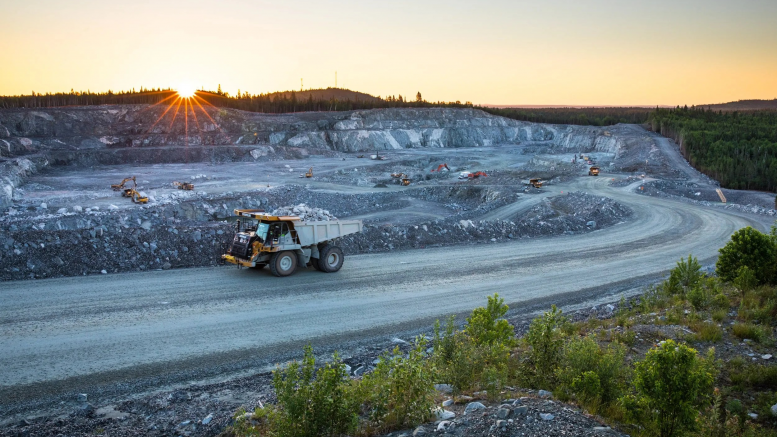
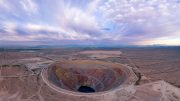
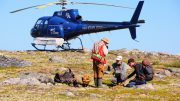
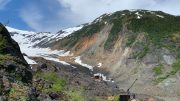
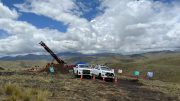
Be the first to comment on "Quebec snapshot: Eight companies seeking gold, base metals, lithium and more"